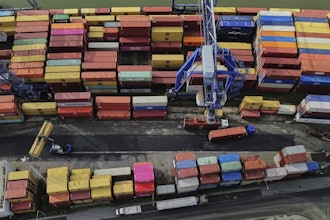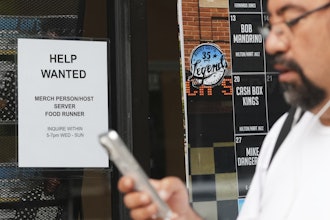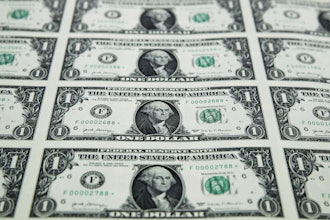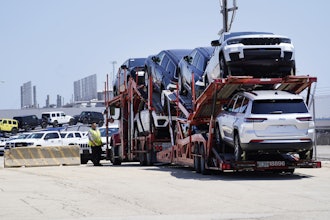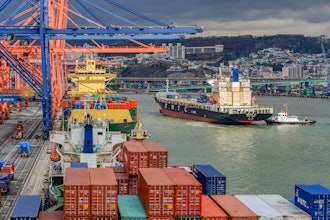
WASHINGTON (AP) — With more than 1 million customers in Louisiana and Mississippi having lost power, Hurricane Ida is sure to take a toll on the energy, chemical and shipping industries that have major hubs along the Gulf Coast. But the impact on the overall U.S. economy will likely be modest so long as damage estimates don't rise sharply and refinery shutdowns are not prolonged, economists say.
The hurricane is expected to inflict a less severe financial impact than Hurricane Katrina did 16 years ago, thanks in part to a lower storm surge and New Orleans’ improved levee system. Analysts at Boenning & Scattergood, a financial consultancy, noted that Ida’s wind field is smaller than Katrina's, which likely narrows the area of catastrophic damage. The analysts estimated that losses for the insurance industry will hit around $10 billion, far less than the $90 billion-plus from Katrina.
Oil prices barely moved Monday as oil companies and refiners assessed any damage from the storm. The price on the New York Mercantile Exchange was flat at $68.74 per barrel. Gasoline futures rose 1.2%.
Still, Ida, which tied for the fifth-strongest hurricane ever to hit the mainland, left so many customers without electricity that any prolonged power outage could have repercussions, at least temporarily, for the oil, natural gas and chemical companies that have operations along the gulf. The longer power remains out, the longer those companies will struggle to restart their operations.
Fewer than 2 million barrels a day of production in the Gulf of Mexico — slightly more than 15% of normal output — is shut down. Yet the disruptions aren’t expected to immediately affect the availability of gasoline nationally because of ample fuel reserves in the system. The U.S. Energy Department announced plans a week ago to sell up to 20 million barrels from the Strategic Petroleum Reserve, the largest sale this year from the federal emergency pool of oil.
“There is a lot of crude oil that could backfill for some of these losses,” said Richard Joswick, an oil analyst with S&P Global Platts.
Refineries with combined capacity of 2.2 million barrels a day were offline Monday, Joswick said, but it could have been far worse: Up to 4 million barrels a day might have had to be turned off had the storm tracked just slightly westward.
“That said, they don’t have power,” he added. “If you don’t have power, you can’t run a refinery.”
For now, the ports of Baton Rouge, Gramercy and Morgan City in Louisiana and the Port of Pascagoula, Mississippi are all closed. The Louisiana Offshore Oil Port has also suspended operations. The Port of New Orleans was closed but reported that “initial reports indicate no major damage to our facilities.’’
Early indications are that refineries along the Gulf Coast were spared the magnitude of damage they suffered during Hurricane Harvey in 2017, which caused flooding that inundated several refineries in the Houston area.
Yet Jacques Rousseau, an analyst for Clearview Energy Partners, cautioned that "we need to wait a little longer to see if there is some sort of extensive damage that could take a refinery out for more than just a shutdown-and-restart period.”
Over the weekend, Phillips 66 closed a refinery in Belle Chasse, Louisiana, and Exxon Mobil began shutting down production at a refinery in Baton Rouge. On Monday, an Exxon spokeswoman said the refinery didn't suffer significant damage and would begin restoring normal operations once the company knows it will have raw materials and power.
All of New Orleans lost power on Sunday evening as the hurricane barreled ashore. Local officials warned that it could take weeks to fully restore power. As the storm approached, offshore oil production in the Gulf was nearly entirely shut down, and crews were evacuated as a precaution.
The hurricane and the resulting disruptions to offshore production and onshore refining are occurring just as demand for gasoline and other fuels is likely to decline, as it typically does in September and October. That trend, if it holds, could lessen the storm's effect on prices.
Most natural disasters cause little overall damage to the $23 trillion U.S. economy. Even the hardest-hit regions often recover quickly, thanks to all the money typically spent on rebuilding from the destruction.
Still, New Orleans’ job market never regained its strength after Hurricane Katrina. In July 2005, the month before the hurricane struck, its metropolitan area had more than 620,000 jobs. It lost 185,000 in September and October that year as people fled the flooded city. Many never returned.
Since then, New Orleans’ recovery has been disrupted by the Great Recession of 2007-2009 and COVID-19, which crushed an economy that depends on tourists. In July, New Orleans had 530,000 jobs, down nearly 15% from its level before Katrina. Over the same period, employment across the United States has risen 9%.
Between Ida and a surge in COVID-19 cases linked to the highly contagious delta variant, the outlook for New Orleans’ fall tourism season has turned from hopeful to bleak.
“We’re on a long road to recovery,’’ said D.J. Johnson, who owns the New Orleans Art Bar and the Baldwin & Co. bookstore, both of which sustained water damage from Ida. “We’ve just been hit very, very hard in New Orleans.’’
Bread on Oak, a New Orleans bakery, will open Tuesday, but only so the owners, Sean and Chamain O’Mahony, can cook up ingredients on a propane grill outdoors. They hope to save at least some of the food that would spoil in refrigerators without electricity.
The O’Mahonys are bracing for a hefty bill once they have to restock everything. And they worry about getting their 30 employees, who are dispersed and without electricity for now, back to work. Sean expects to lose some of them to better-paying jobs working on crews that will be making post-Ida repairs around the city.
Though such personal losses are many, Adrienne Slack, a vice president at the New Orleans branch of the Federal Reserve Bank of Atlanta, called the overall preliminary damage reports “favorable.’’
“The levee structures are much improved since (Katrina), and they held up very well," Slack said. "We’re not looking at a city that will be underwater for three weeks.’’
She cautioned that the damage assessments will take time and that the local economy can’t return to life until electricity is flowing again.
Cellphone service was severely disrupted by the storm. T-Mobile said its network was operating at only 70% of capacity in Louisiana and Alabama. AT&T said it was running at 60% of capacity in Louisiana.
On a national scale, Mark Zandi, chief economist at Moody’s Analytics, said the disruptions caused by Ida will likely lead him to downgrade his forecast for annual U.S. economic growth in the current July-September quarter by a few tenths of a percentage point. But that economic loss, Zandi said, could be reversed in the final quarter of the year as a result of the rebuilding from the hurricane’s damage that will likely follow.
Analysts at Citi Investment Research agreed that any drag on growth will likely be offset by subsequent reconstruction. They said, though, that “inflationary effects may be more persistent as demand for building materials, autos and workers will confront already existing shortages.”
“The key channel for Ida to impact the broader economy is through energy prices,” Zandi said. “We will have to see how much damage occurred to production in the Gulf and how long that production will stay offline.”
“The worst-case scenario is Ida might add 10 cents to 20 cents to the price of a gallon of gas through September,” he said. But he suggested that the increase in pump prices might last for only a few weeks.
Likewise, Joswick, the analyst with S&P Global Platts, foresees nothing like the jump in pump prices that occurred after Katrina, when the average retail price jumped more than 70 cents in just over a week, according to government figures.
“This is a much more modest event," he said “We’ll likely recover in a week or two.”
Robert Handfield, a professor of supply chain management at North Carolina State University, said he worries that disruptions at petrochemical plants will cut off supplies to plastics factories, which are still struggling to rebound from a February deep freeze in Texas and from supply-chain bottlenecks.
“They’re already behind where they should be,’’ Handfield said. “The inventories are pretty scarce.’’











